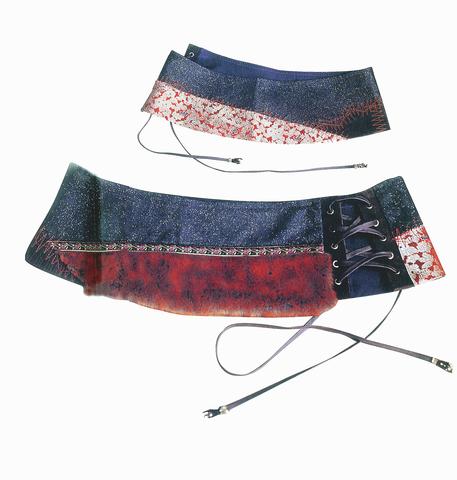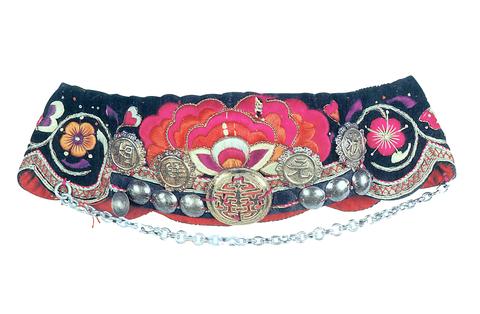Long acclaimed for her oriental-flavored works, fashion designer Fu Tzu-ching (傅子菁) has now taken her designs from her boutiques to the National Museum of History for its current exhibition.
With its juxtaposition of 60 late-Ching dynasty clothing items and 40 of Fu's Chinese-flavored designs made in the past two years, Style and Fashion offers a chance for fashionistas to get in touch with the clothing tradition that has inspired today's designs.
Since the handover of Hong Kong to Chinese rule in 1997 inspired fashion designers worldwide to integrate Chinese motifs into their designs, the craze for designs with a Chinese touch has continued to this day with the help of Prada, Christine Dior and Jean-Paul Gaultier, among others.

PHOTO COURTESY OF THE NATIONAL MUSEUM OF HISTORY
Outside the fashion circle, the line of APEC leaders in embroidered Chinese jackets with peony patterns at the closing session of last year's summit in Shanghai fanned even more interest in Chinese themes in fashion.
Since Shiatzy Chen (夏姿) established her brand in 1978 with lustrous Chinese designs, several Taiwanese designers have made Chinese flavor their style. Among them are Wen Chin-chu(溫慶珠), Lu Fang-chi (呂芳智), Huang Jia-chun (黃嘉誠) as well as Fu. Compared with them, "Fu's signature use of collages consisting of various types of fabrics and ethnic patterns go well with the traditional clothing on show," said Liu Hsiao-yan (劉小燕), public affairs coordinator at the museum.
Dating back as far as 1863, these carefully preserved pieces provide a glimpse of the style of dress that has been revived by Fu along with other designers.

PHOTO COURTESY OF THE NATIONAL MUSEUM OF HISTORY
Around the end of the 19th century, Taiwan's textile industry was not yet developed. Immigrants from Fujian and Guangdong provinces in China, especially wealthy traders, imported cloth from these two provinces, which strongly influenced the fashion trends here.
After being shipped to Taiwan, the fabrics were made into items much more glamorous than their mainland counterparts, owing to the immigrants' taste for color and flair. A jacket of leopard skin-imitation velvet on show illustrates the phenomenon.
Many of the exhibits are made of silk, satin, gauze and other luxury fabrics. As needlework was then a popular pastime among women, some dresses were covered with delicate and auspicious embroidered symbols of fish, children and magpies, which were sometimes arranged into a whole landscape. The interesting designs and the apparent care taken to execute them make these patterned dresses the highlight of the show.

"So far, viewers have expressed great interest in the show, because the combination of traditional clothing and present-day fashion designs in a museum context were unprecedented in Taiwan," said Liu.
However, despite the innovative concept, it remains doubtful whether showing the works of a single designer can provide meaningful insight into the influence of old designs on today's fashion world.

In the March 9 edition of the Taipei Times a piece by Ninon Godefroy ran with the headine “The quiet, gentle rhythm of Taiwan.” It started with the line “Taiwan is a small, humble place. There is no Eiffel Tower, no pyramids — no singular attraction that draws the world’s attention.” I laughed out loud at that. This was out of no disrespect for the author or the piece, which made some interesting analogies and good points about how both Din Tai Fung’s and Taiwan Semiconductor Manufacturing Co’s (TSMC, 台積電) meticulous attention to detail and quality are not quite up to

April 21 to April 27 Hsieh Er’s (謝娥) political fortunes were rising fast after she got out of jail and joined the Chinese Nationalist Party (KMT) in December 1945. Not only did she hold key positions in various committees, she was elected the only woman on the Taipei City Council and headed to Nanjing in 1946 as the sole Taiwanese female representative to the National Constituent Assembly. With the support of first lady Soong May-ling (宋美齡), she started the Taipei Women’s Association and Taiwan Provincial Women’s Association, where she

Chinese Nationalist Party (KMT) Chairman Eric Chu (朱立倫) hatched a bold plan to charge forward and seize the initiative when he held a protest in front of the Taipei City Prosecutors’ Office. Though risky, because illegal, its success would help tackle at least six problems facing both himself and the KMT. What he did not see coming was Taipei Mayor Chiang Wan-an (將萬安) tripping him up out of the gate. In spite of Chu being the most consequential and successful KMT chairman since the early 2010s — arguably saving the party from financial ruin and restoring its electoral viability —

It is one of the more remarkable facts of Taiwan history that it was never occupied or claimed by any of the numerous kingdoms of southern China — Han or otherwise — that lay just across the water from it. None of their brilliant ministers ever discovered that Taiwan was a “core interest” of the state whose annexation was “inevitable.” As Paul Kua notes in an excellent monograph laying out how the Portuguese gave Taiwan the name “Formosa,” the first Europeans to express an interest in occupying Taiwan were the Spanish. Tonio Andrade in his seminal work, How Taiwan Became Chinese,